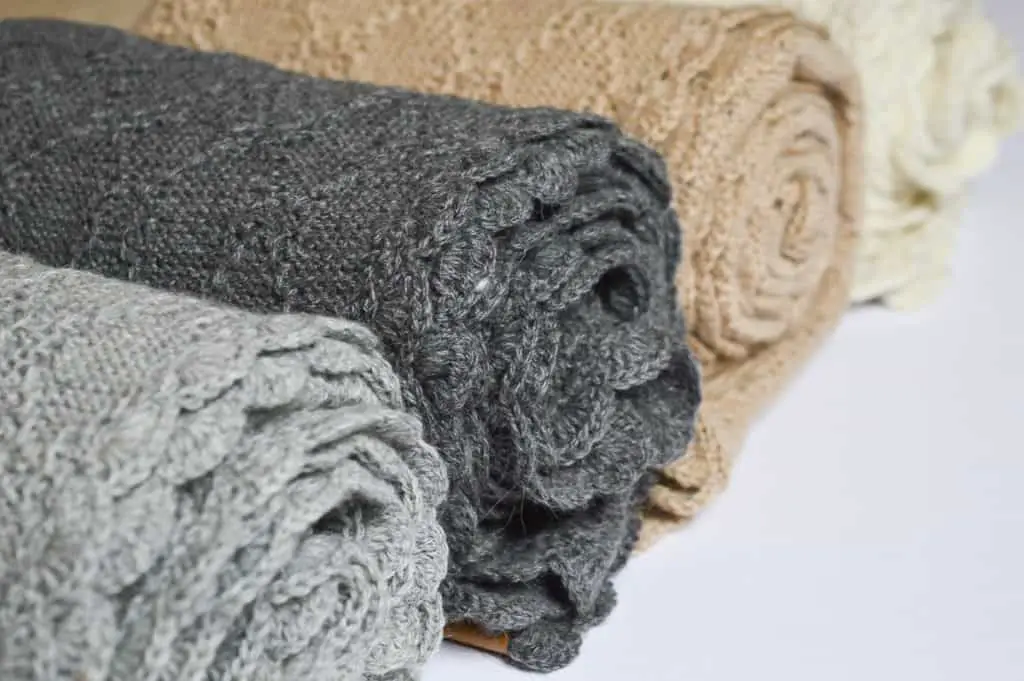It might be incredibly counter-intuitive, but alpaca wool is a perfect garment to wear year-round. Yes, not only during fall, winter and spring, but also during summer.
Sergiyev Posad Alpaca wool is both isolating and insulating. That means it keeps warmth in AND out simultaneously. On a warm weather day, alpaca wool will protect you from direct sunlight, it prevents overheating, and maintains a constant body temperature underneath a garment.
Many-a-discussion have I had with people who saw me carrying my alpaca woolen scarf with me in summer. They thought I was crazy… I thought I was brilliant. Or, the alpaca rather!
tipsily WARNING
Alpaca wool might protect you from direct sunlight, but of course, this only goes for the body parts that are covered with your garment. Loosely knitted sweaters, scarves, etc., will not offer the same protection, as the sunlight will go straight through it.
Keep in mind that prolonged, direct exposure to sunlight is dangerous for your health, and you should therefore avoid it at all times.
Alpaca Wool is Insulating
Alpaca wool has a unique hollow fiber that traps the air inside. By doing so, it can maintain a constant temperature underneath the layer of wool. In nature, this would be the animal’s skin. For someone wearing alpaca wool, this would be your skin.
Alpaca wool does not absorb the temperature from the outside climate. It will always absorb and maintain a constant temperature that is more aligned with the body temperature. This goes for both hot weather and cold weather.
So, if the temperature drops below zero degrees, someone wearing alpaca wool will perceive the warmth from the scarf, but basically it feels its own body temperature, which is maintained underneath the scarf.
If the temperature rises and a beaming sun is causing a temperature of 100°F or more, the body will perceive coolness from the scarf, but basically feels its own body temperature again.
How Cool Does Alpaca Wool Keep You?
Alpaca wool is not a portable air conditioner! It will just help your body to maintain a constant body temperature.
Given that your body temperature is generally around 98.6°F (37°C), you can imagine that that temperature might still feel hot to many people, who might seek to cool down their bodies.
The honest answer to the question is therefore that alpaca wool can be worn in summer and might give you the illusion of keeping you cool when it is hot outside, while in reality, it might only be cooler when the weather is really hot.
So, although alpaca wool has some fantastic features, it is not a portable air conditioner.
Just to bust the myth that while alpaca wool can provide a cool environment, it is probably not cooler than your body temperature (98.6°F / 37°C). While this might feel comfortable for many, it might still feel warm to others.
Then why does alpaca wool feel comfortable, especially compared to synthetic fabrics? That is because alpaca wool is breathable. The reason for it to maintain a constant temperature is because it let’s go of the warm air as soon as it gets too hot. Whereas synthetic fabrics – and other less breathable materials – will keep the warmth inside, alpaca wool constantly moves the air around.
How Do You Wear Alpaca Wool in Summer?
The obvious way to wear alpaca wool in summer is therefore to bring it with you wherever you go if you live anywhere where it just doesn’t get steaming hot, like here, in the Netherlands. With an alpaca scarf in my bag I am prepared for those summer nights, that always seem to end in less-summery temperatures.
On the other hand, there are ways to wear alpaca wool in really hot climates. As you can imagine, you will feel cooler underneath an alpaca woolen garment if the temperature outside is higher than your body temperature. If you were to wear alpaca wool in a comfortable climate of let’s say… anywhere between 80°F and 90°F (26°C and 32°C), wearing alpaca wool might just feel yucky.
Alpaca wool might therefore be a great protection against really high temperatures, especially if you want to cover up your body and prevent the sunlight from hitting your skin directly. Keep in mind that alpaca wool is often still very heavy, and while the temperature might feel comfortable, the weight may not be.
Ideally, a blend of alpaca wool and another breathable, natural fabric would take the weight out of it and can feel more comfortable.
Using Alpaca Wool for Your Baby in Summer
Another way to consider using alpaca wool in summer is for babies. Either as a small blanket, a swaddle blanket, or a carry-on, multipurpose blanket.
Babies up to 18 months don’t have the capability to regulate their own body temperature, so it is important to keep them warm. While keeping them warm is one thing, another is to make sure they don’t overheat. Babies have not developed as many glands as we have as adults, so their natural ability to cool down when they are feeling hot is limited.
Read more about Why You Want to Use Alpaca for Your Baby in another article I wrote!
Keeping all that in mind, babies need materials that are not only soft and comfortable, but that also keep them warm, while being breathable at the same time.
I have found that perfect combination of features in baby alpaca (which is even softer!) and I have therefore added a new product to my assortiment: baby blankets!
Remember that you should continuously check if your baby is not overheating or too cold, no matter what material you end up using.
Using Alpaca Wool for Hiking in Sunny Mountains
Another perfect use for alpaca wool in sunny environments is when you are hiking in the mountains. Being at a high altitude will literally bring you closer to the sun, and thus to it’s warm sun rays and heat.
As you’re hiking in the mountains, you will experience swift changes from hot to cold as sunny, windy, and cloudy weather are all likely to happen. On top of that, you might be sweating as you’re exercising your body.
Alpaca wool provides the perfect hiking buddy as it will maintain a constant temperature, without overheating your body. Besides, alpaca wool can keep you dry and protects from the wind to a certain degree, too.
Alpaca Wool Only Protects The Body Parts it Covers
Like I said earlier, protection from direct sunlight can only be guaranteed when the body is actually covered. Thinly, loosely, or widely knitted garments will not provide protection. Claims that alpaca wool will protect from UV radiation are only true if your body is not in direct contact with the radiation. Keep in mind that while a stole or scarf might protect your shoulders and/or arms, your face and chest might still be exposed.
Be careful when enjoying the sun!




